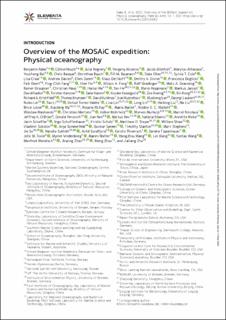| dc.contributor.author | Rabe, Benjamin | |
| dc.contributor.author | Baumann, Till Martin | |
| dc.contributor.author | Divine, Dmitry | |
| dc.contributor.author | Fer, Ilker | |
| dc.contributor.author | Gradinger, Rolf Rudolf | |
| dc.contributor.author | Granskog, Mats | |
| dc.contributor.author | Koenig, Zoe Charlotte | |
| dc.contributor.author | Muilwijk, Morven | |
| dc.contributor.author | Sundfjord, Arild | |
| dc.date.accessioned | 2022-05-30T11:00:23Z | |
| dc.date.available | 2022-05-30T11:00:23Z | |
| dc.date.created | 2022-02-07T10:13:56Z | |
| dc.date.issued | 2022 | |
| dc.identifier.issn | 2325-1026 | |
| dc.identifier.uri | https://hdl.handle.net/11250/2996748 | |
| dc.description.abstract | Arctic Ocean properties and processes are highly relevant to the regional and global coupled climate system, yet still scarcely observed, especially in winter. Team OCEAN conducted a full year of physical oceanography observations as part of the Multidisciplinary drifting Observatory for the Study of the Arctic Climate (MOSAiC), a drift with the Arctic sea ice from October 2019 to September 2020. An international team designed and implemented the program to characterize the Arctic Ocean system in unprecedented detail, from the seafloor to the air-sea ice-ocean interface, from sub-mesoscales to pan-Arctic. The oceanographic measurements were coordinated with the other teams to explore the ocean physics and linkages to the climate and ecosystem. This paper introduces the major components of the physical oceanography program and complements the other team overviews of the MOSAiC observational program. Team OCEAN’s sampling strategy was designed around hydrographic ship-, ice- and autonomous platform-based measurements to improve the understanding of regional circulation and mixing processes. Measurements were carried out both routinely, with a regular schedule, and in response to storms or opening leads. Here we present along-drift time series of hydrographic properties, allowing insights into the seasonal and regional evolution of the water column from winter in the Laptev Sea to early summer in Fram Strait: freshening of the surface, deepening of the mixed layer, increase in temperature and salinity of the Atlantic Water. We also highlight the presence of Canada Basin deep water intrusions and a surface meltwater layer in leads. MOSAiC most likely was the most comprehensive program ever conducted over the ice-covered Arctic Ocean. While data analysis and interpretation are ongoing, the acquired datasets will support a wide range of physical oceanography and multi-disciplinary research. They will provide a significant foundation for assessing and advancing modeling capabilities in the Arctic Ocean. | en_US |
| dc.language.iso | eng | en_US |
| dc.publisher | University of California Press | en_US |
| dc.rights | Navngivelse 4.0 Internasjonal | * |
| dc.rights.uri | http://creativecommons.org/licenses/by/4.0/deed.no | * |
| dc.subject | Fysisk oseanografi | en_US |
| dc.subject | Physical oceanography | en_US |
| dc.subject | Polarforskning | en_US |
| dc.subject | Polar research | en_US |
| dc.subject | Polaroseanografi | en_US |
| dc.subject | Polar oceanography | en_US |
| dc.title | Overview of the MOSAiC expedition: Physical oceanography | en_US |
| dc.title.alternative | Overview of the MOSAiC expedition: Physical oceanography | en_US |
| dc.type | Journal article | en_US |
| dc.type | Peer reviewed | en_US |
| dc.description.version | publishedVersion | en_US |
| dc.rights.holder | Copyright 2022 The Author(s). | en_US |
| dc.source.articlenumber | 00062 | en_US |
| cristin.ispublished | true | |
| cristin.fulltext | original | |
| cristin.qualitycode | 1 | |
| dc.identifier.doi | 10.1525/elementa.2021.00062 | |
| dc.identifier.cristin | 1998415 | |
| dc.source.journal | Elementa: Science of the Anthropocene | en_US |
| dc.relation.project | Norges forskningsråd: 280531 | en_US |
| dc.subject.nsi | VDP::Oseanografi: 452 | en_US |
| dc.subject.nsi | VDP::Oceanography: 452 | en_US |
| dc.identifier.citation | Elementa: Science of the Anthropocene. 2022, 10 (1), 00062. | en_US |
| dc.source.volume | 10 | en_US |
| dc.source.issue | 1 | en_US |

